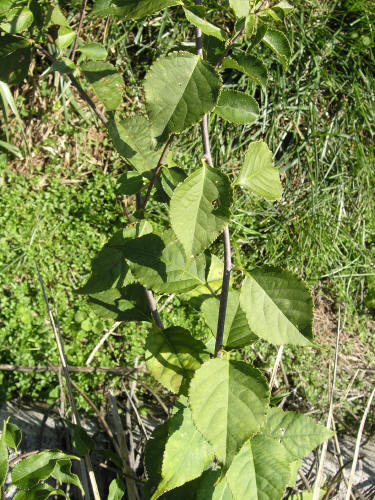Oriental Bittersweet, Roundleaved Bittersweet, Chinese Bittersweet
Celastrus orbiculatus Thunb.
Spindletree Family (Celastraceae)

▲ vine covering a yucca plant
▲▼ fruit plants
▲ young vine

▲ vine showing leaf and stem details
Chinese Bittersweet, Oriental Bittersweet, Roundleaved Bittersweet: (Not in Weeds of the Midwestern United States and Central Canada; not in Weeds of the Great Plains; pp. 336-337, Weeds of the Northeast)
· Woody perennial vines in the Spindletree Family (Celastraceae) that climbs by twining
· Stems are bright green, becoming gray as they mature
· Leaves are opposite, oval-shaped to nearly rounded, hairless, bright green
· Plants are dioecious (separate male and female plants), with flowers or fruit (fruit only on female vines) in clusters in the axils of the leaves
· Fruit is a yellow orange capsule that opens in 3 sections to show 3 red fleshy fruits, each with 1-2 seeds
· Found in open and more dense wooded areas, streambanks, fencerows, landscapes, disturbed sites
· Can form dense mats of vegetation over native species, killing them out
· Was introduced for its fruit, which are used in floral arrangements, but has escaped cultivation and become invasive
· Important to distinguish from the increasingly less common native American Bittersweet before controlling, by looking for the following distinguishing characteristics:
o Leaves: American Bittersweet leaves more oval, at least twice as long as wide; Chinese or Oriental Bittersweet has more rounded leaves less than twice as long as wide
o Fruit: American bittersweet has flowers/fruit in terminal panicles at tips of stems, and the fruit capsule is more orange; Chinese Bittersweet has flowers/fruit in axils of leaves and the fruit capsule is more yellow-orange
Location near campus: in hedgerow along alley that runs behind (north) of houses along Loren St. south of campus.